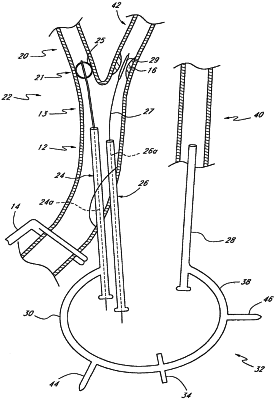| CPC A61B 17/12109 (2013.01) [A61B 17/12036 (2013.01); A61B 17/12045 (2013.01); A61B 17/12136 (2013.01); A61B 17/22 (2013.01); A61B 17/320758 (2013.01); A61B 17/3415 (2013.01); A61F 2/82 (2013.01); A61M 1/34 (2013.01); A61M 1/36 (2013.01); A61M 1/3613 (2014.02); A61M 1/3655 (2013.01); A61M 1/67 (2021.05); A61M 25/09 (2013.01); A61M 25/104 (2013.01); A61M 25/1011 (2013.01); A61M 27/002 (2013.01); A61B 2017/12127 (2013.01); A61B 2017/22001 (2013.01); A61B 2017/22055 (2013.01); A61B 2017/22065 (2013.01); A61B 2017/22067 (2013.01); A61B 2017/22069 (2013.01); A61B 2017/320716 (2013.01); A61M 1/3633 (2013.01); A61M 2025/0177 (2013.01); A61M 2025/1052 (2013.01); A61M 2205/3331 (2013.01); A61M 2205/3334 (2013.01); A61M 2205/7545 (2013.01)] | 30 Claims |

|
1. A method of treating a lesion in an artery of a patient, comprising:
forming an arterial access location in a common carotid artery;
positioning at least a portion of the arterial access device into the common carotid artery via the arterial access location;
causing blood to flow from the carotid artery to a return location via the arterial access device and a shunt connected to the arterial access device by at least one of:
(1) actively pumping blood from the carotid artery to the return location via the arterial access device and the shunt connected to the arterial access device; and
(2) occluding blood flow in at least a portion of the carotid artery to form a pressure gradient that establishes retrograde blood flow through the carotid artery such that blood flows into the arterial access device and the shunt connected to the arterial access device;
wherein the arterial access device comprises an elongate member defining an internal lumen that extends from a distal opening at a distal region of the arterial access device to a proximal opening at a proximal region of the arterial access device, wherein the internal lumen receives blood flow through the distal opening from the common carotid artery, and wherein the shunt comprises a shunt lumen connected to the arterial access device at a location between the distal and proximal openings of the arterial access device, and wherein the shunt provides a pathway for blood to flow out of the internal lumen of the arterial access device at a location between the distal and proximal openings of the arterial access device; and
treating the lesion by deploying a stent on the lesion.
|